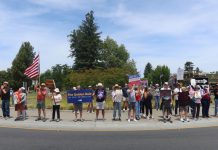Windsor resident Charya Burt has multiple accolades for her dancing and community engagement, but one more has been added to her list. The Americans for the Arts organization announced two dance artists as recipients of the 2022 Johnson Fellowship for Artists Transforming Communities — Burt being one of them.
The Johnson Fellowship honors an individual artist who demonstrates a sustained commitment to civic participation through their work, and who has made a positive and meaningful difference to inspire, engage, challenge and celebrate communities through arts and culture, according to a press release from the organization. Also honored was Christopher “Mad Dog” Thomas of Chicago. Each is recognized with a $35,000 award.
Burt teaches classical Cambodian dance and through her dancing hopes to help the Cambodian diaspora after the traumatic effects of the Khmer Rouge Genocide. Burt’s cultural identity is one of her biggest strengths, an emblem of herself. She trained with Cambodia’s dance masters who are genocide survivors and in her life as a dancer, she has dedicated herself to preserving the culture and teaching others about it.
Burt wants new generations to learn about Cambodian culture and be able to maintain the long relationship between two different cultures. At the same time, she wants her dancing to spark conversations on issues such as immigrant and refugee displacement, colorism and racism.
“After this civil war, I was part of that generation that was taught by many master teachers who survived the war, and they rebuilt the culture. I was a young student when I started, when I saw all the efforts of those master teachers and artists,” Burt said.
Burt believes in equity and tradition and wants to combine both through dancing — a visual representation of what she hopes for her ancestors and new generations.
“Seeing that the Cambodian culture has enormous loss of Cambodian art during the genocide, I feel so obligated to try to continue to learn and to pass down these cultural traditions, to the next generations. That’s a deep passion of mine to be able to preserve and promote Cambodian arts and culture in America,” she said.
One of the many reasons she believes strongly about preserving her culture is the personal relationship she had with her own teachers. Now, she facilitates apprenticeships to help young artists become teachers like herself. She said she has seen young generations have passion and deep admiration for their culture and they want to continue to preserve it, which is her ultimate goal.
Charya Burt
Burt grew up in Cambodia but moved to Sonoma County 30 years ago. She emigrated with her husband after getting married. Though most of her work is outside Sonoma County, in 2017 she performed a piece called “Princess and Peacocks” in Santa Rosa.
When it comes to her fellowship, Burt is both excited and humbled to be a recipient.
“I am honored. This means so much just because it will allow me to continue to do my work, to continue to do community outreach, to really further develop what I do a lot more,” she said.
Currently, she is working on two production pieces. A dance group she is developing called “The Rebirth of Apsara” will premiere on Jan. 7, 2024, Cambodian Victory Over Genocide Day. Another is called “Beautiful Dark” which will explore the social and psychological impact of colorism. She will partner with an organization called Mosaic America to do outreach to the immigrant community of color in the Bay Area.
“When I was growing up as a child, I was kind of picked on because I was dark. I had dark skin and that (was not) considered beautiful. I am sure in other cultures it is, so this topic is pretty close to what I experienced,” Burt said. “For me, exploring this topic is a way to bring awareness to a lot of people who try to change who they are by whitening their skin so that they can be socially accepted. It is important to be comfortable in your own skin. Reclaiming your identity in a way to say that beauty is what you are if you are comfortable with who you are.”
Even though her work is mainly outside of the area, Burt hopes to be able to work more in Sonoma County.
“I feel peaceful, coming home, Sonoma County is a beautiful place. I wish that I had more opportunity to present my work locally here, to connect, you know, to be able to do more local work here. I am still very fortunate to do the work that I do and be able to create work and present it nationally, I feel very fortunate about that,” Burt said.








